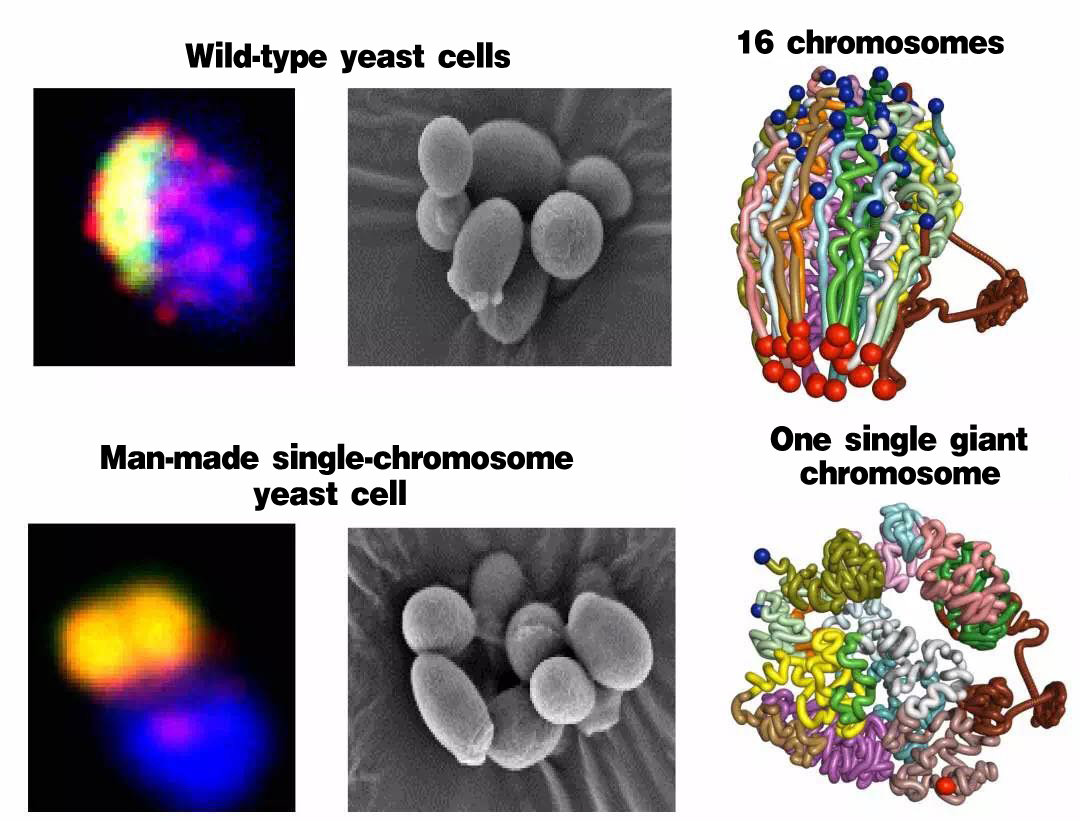Reported by SONG Jianlan

Generally, nucleus-carrying cells have their genome divided into multiple chromosomes. To understand the consequence of manipulating the number of chromosomes in a eukaryotic cell, the joint team from three CAS institutes in Shanghai adventure to fuse the 16 chromosomes in a yeast cell together to produce a huge sing chromosome. Surprisingly, this big change seems to make little damage to the fitness of the cell, though it does affect its growth across different environments, competitiveness, gamete production and viability. (Credit: SIPPE & SIBCB)
Generally, a nucleus-bearing cell has multiple chromosomes, to hold those double-helix chains called DNAs in different “baskets.” All in all, the coding on the “eggs” – those chains – programs how the cell produces the biochemical molecules vital for its whole lifetime, and hence might deserve careful protection. The number of chromosomes varies across species: Human cells each have 46 chromosomes, mice cells 40, fly cells 8, and rice cells 24. How important is the number of “portions” into which a genome is divided? What will happen if we, human beings, change the number of chromosomes? Or, can we put all the genome of an organism into only one single chromosome, without affecting its activity? These remained a long-pending mystery, until scientists from two CAS institutes in Shanghai made the first successful ever attempt to manipulate this sacred number.
The team, jointly led by Profs. QIN Zhongjun, XUE Xiaoli and ZHAO Guoping from the CAS Shanghai Institute of Plant Physiology and Ecology (SIPPE, also known as the CAS Center for Excellence in Molecular Plant Sciences), and Prof. ZHOU Jinqiu from the CAS Shanghai Institute of Biochemistry and Cell Biology (SIBCB, also known as the CAS Center for Excellence in Molecular Cell Science) fused together end-to-end the 16 chromosomes in a cell of a eukaryotic creature, the budding yeast Saccharomyces cerevisiae, and deleted the redundant centromeres. They thus created a “simplified” form of life that does not exist in nature – a eukaryotic cell that has only one (huge) chromosome.
Surprisingly, this reduction in number of chromosomes, and also interactions between different parts of the chromosome due to the loss of centromeres, did not cause noticeable damage in the “fitness” of the cell, despite the remarkable change in the 3D structures of the chain. “However, the single-chromosome and wild-type yeast cells have nearly identical transcriptome and similar phenome profiles. The giant single chromosome can support cell life, although this strain shows reduced growth across environments, competitiveness, gamete production and viability,” reported the team in their paper published in Nature.
As noted by Gianni Liti in his commentary published in Nature, “… these engineered yeast strains constitute powerful resources for studying fundamental concepts in chromosome biology, including replication, recombination and segregation.”
This might also be the biggest move so far to reconstruct a genome.
References
1. Yangyang Shao, Ning Lu, Zhenfang Wu, Chen Cai, Shanshan Wang, Ling-Li Zhang, Fan Zhou, Shijun Xiao, Lin Liu, Xiaofei Zeng, Huajun Zheng, Chen Yang, Zhihu Zhao, Guoping Zhao*, Jin-Qiu Zhou*, Xiaoli Xue*, Zhongjun Qin*, Creating a Functional Single-Chromosome Yeast. Nature 560, 331-335 (Published: August 01, 2018). doi: 10.1038/s41586-018-0382-x
2. G. Liti, Yeast Chromosome Numbers Minimized Using Genome Editing. Nature 560, 317-318 (Published: August 01, 2018). doi: 10.1038/d41586-018-05309-4

